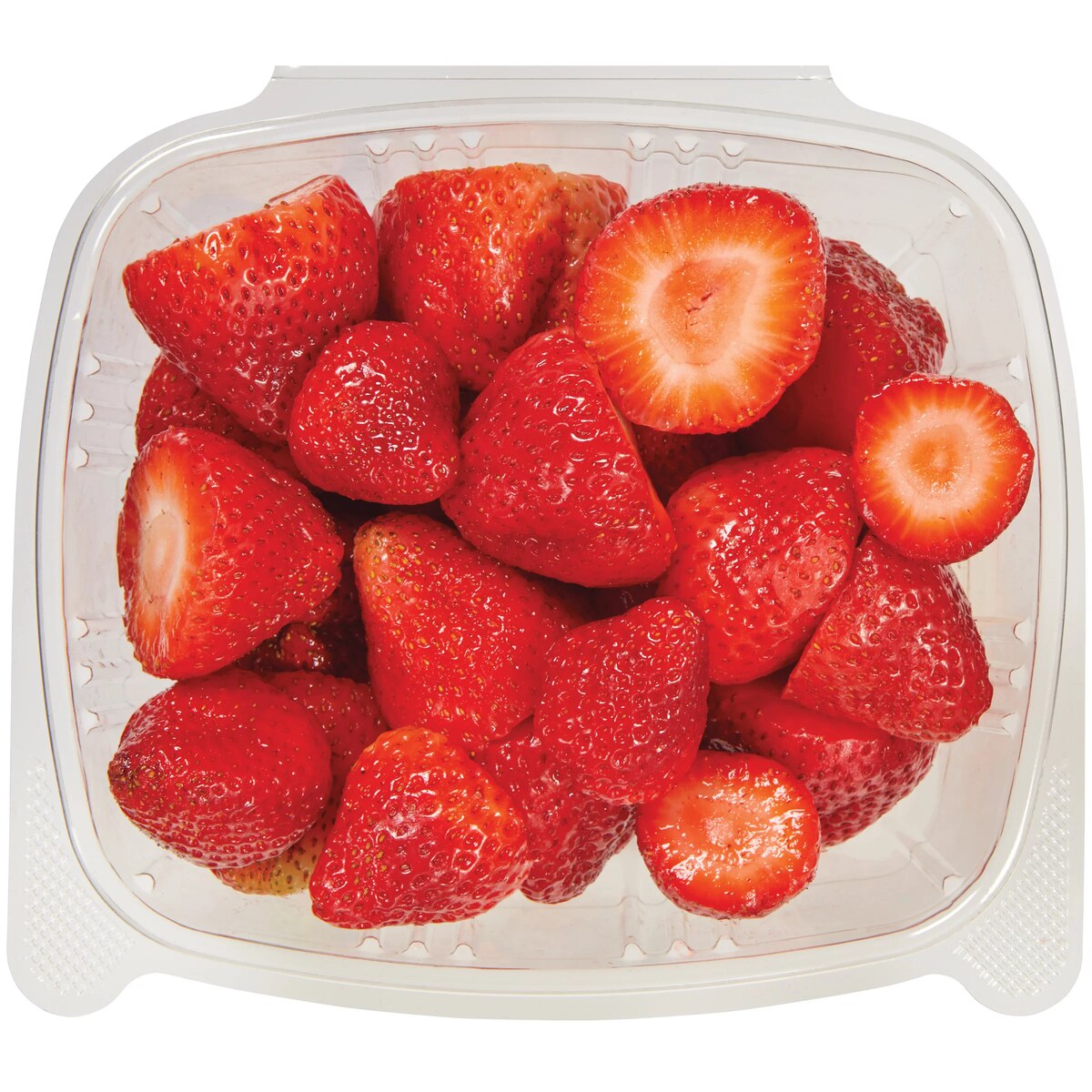

Articles
How To Store Strawberries In The Freezer
Modified: August 30, 2024
Learn the best way to store strawberries in the freezer with our informative articles. Preserve the freshness and taste of your favorite berries all year round.
(Many of the links in this article redirect to a specific reviewed product. Your purchase of these products through affiliate links helps to generate commission for Storables.com, at no extra cost. Learn more)
Introduction
Welcome to our comprehensive guide on how to store strawberries in the freezer. Whether you’ve picked a batch of fresh strawberries from your garden or bought them in bulk from the farmers’ market, freezing them is a great way to preserve their freshness and flavor for later use.
Freezing strawberries not only extends their shelf life but also allows you to enjoy the taste of summer all year round. Whether you plan to use them in smoothies, pies, jams, or desserts, properly storing your strawberries will ensure their quality is maintained.
In this article, we will walk you through a step-by-step process to clean, prepare, and package your strawberries for freezing. We will also provide tips on how to thaw and utilize them effectively once frozen. By following these guidelines, you can enjoy delicious strawberries that taste just as good as the day you froze them!
Key Takeaways:
- Preserve the taste of summer by freezing strawberries properly. Clean, cut, and package them in freezer-safe containers to enjoy their freshness in smoothies, desserts, and more all year round.
- Thaw frozen strawberries gently to maintain their texture and flavor. Use them within 2-3 days and avoid refreezing for the best results. Enjoy the burst of summer sweetness in your recipes!
Read more: How To Store Strawberries And Blueberries
Step 1: Cleaning and Preparing the Strawberries
Before freezing your strawberries, it is important to clean and prepare them properly to remove any dirt, debris, or pesticides. Follow these simple steps to ensure your strawberries are fresh and ready for freezing:
- Start by pouring cool water into a bowl or sink. Avoid using hot water, as it can cause strawberries to become mushy.
- Place the strawberries in the water and gently swirl them around. This will help dislodge any dirt or chemicals clinging to the surface.
- Using a colander or strainer, drain the water from the strawberries. Rinse them under running water to remove any remaining debris.
- Use a clean kitchen towel or paper towels to gently pat dry the strawberries. Make sure they are completely dry before moving on to the next step.
- Once the strawberries are dry, carefully remove the green tops by either cutting them off with a knife or pinching them off with your fingers. Discard the tops or consider composting them.
- Inspect the strawberries for any signs of bruising or mold. Discard any berries that appear spoiled or damaged as they can adversely affect the quality of the rest of the batch.
By following these cleaning and preparation steps, you can ensure that your strawberries are free from dirt and chemicals, which will help maintain their taste and texture during freezing and thawing.
Step 2: Removing the Tops and Cutting the Strawberries
After cleaning and drying the strawberries, the next step is to remove the tops and cut them into your desired size. Here’s how to do it:
- Take each strawberry and hold it firmly between your thumb and index finger.
- Using a paring knife, carefully cut off the green tops and any remaining white pith just below the stem. Make sure to remove as little fruit as possible.
- For smaller strawberries, you can leave them whole if preferred. Otherwise, you can slice them into halves or quarters based on your preference.
- If you plan to use the strawberries for specific recipes, such as pies or cakes, consider cutting them into uniform slices. This will help ensure even distribution and consistency in your final dish.
Remember, the size and shape at which you cut the strawberries will depend on how you plan to use them in the future. By removing the tops and cutting them into manageable pieces, you’ll make it easier to use the strawberries in various recipes once they are frozen.
Step 3: Packaging the Strawberries for Freezing
Once you have cleaned and cut the strawberries, it’s time to package them properly for freezing. Packaging them correctly will help maintain their quality and prevent the formation of ice crystals. Follow these steps to ensure your strawberries stay fresh:
- Choose the Right Containers: Opt for airtight containers or freezer bags specifically designed for freezing. Using containers that are freezer-safe will help protect the strawberries from freezer burn and maintain their flavor.
- Portion the Strawberries: Divide the strawberries into convenient portion sizes that you are likely to use in one go. This will make it easier for you to grab the required amount without thawing the entire batch.
- Sealing the Containers: Fill each container with the prepared strawberries, leaving some headspace at the top to allow for expansion during freezing. Seal the containers tightly to prevent any air from entering or moisture from escaping.
- Label and Date the Containers: It’s essential to label each container with the contents and the date of freezing. This will help you keep track of the storage time and ensure that you use the oldest strawberries first.
- Remove Air from Freezer Bags: If you’re using freezer bags, remove as much air as possible from the bags before sealing. This will help prevent freezer burn and maintain the strawberries’ quality.
It’s important to note that strawberries can release some liquid while freezing, which may mix with the sugar syrup or juice. To prevent this, you can pre-freeze the strawberries on a baking sheet before transferring them to containers or bags. This will help them retain their shape and reduce excess moisture.
By following these packaging guidelines, you’ll ensure that your strawberries stay fresh, maintain their flavor, and are easy to use in future recipes.
To store strawberries in the freezer, first wash and dry them thoroughly. Then, remove the stems and arrange the strawberries in a single layer on a baking sheet. Place the baking sheet in the freezer until the strawberries are frozen solid, then transfer them to a resealable plastic bag or airtight container for long-term storage. This method prevents the strawberries from sticking together and allows you to easily grab a handful whenever you need them.
Step 4: Storing the Packaged Strawberries in the Freezer
Properly storing the packaged strawberries in the freezer is crucial to maintain their quality and prevent freezer burn. Here are the steps to follow:
- Find a Flat Surface: Clear a flat space in your freezer where you can lay the containers or freezer bags flat. This will help the strawberries freeze quickly and evenly.
- Arrange the Containers/Bags: Place the containers or bags in a single layer on the flat surface of the freezer. Avoid stacking them on top of each other initially, as this can cause them to freeze unevenly.
- Leave Space for Air Circulation: Make sure to leave some space between the containers or bags to allow for proper air circulation. This will help maintain a consistent temperature within the freezer.
- Keep Away from Strong Odors: Store the strawberries away from foods with strong odors, as they can absorb those flavors. Optimal storage locations include the bottom or back of the freezer, where the temperature remains the most consistent.
- Do Not Overload the Freezer: Avoid overcrowding the freezer with too many items, as this can affect the freezer’s temperature and freeze the strawberries at a slower rate.
It’s important to note that strawberries can be stored in the freezer for up to 6-8 months. However, for the best flavor and quality, it is recommended to use them within 3-4 months.
By following these storage guidelines, your frozen strawberries will be ready to use whenever you’re craving that burst of summer sweetness in your recipes.
Read more: How To Store Strawberries In Refrigerator
Step 5: Thawing and Using Frozen Strawberries
When the time comes to use your frozen strawberries, it’s important to thaw them properly to preserve their texture and flavor. Here’s how to safely thaw and enjoy your frozen strawberries:
- Refrigerator Thawing: The best and safest way to thaw frozen strawberries is by transferring them from the freezer to the refrigerator. Place the sealed container or bag in the fridge and let them thaw slowly overnight or for about 6 to 8 hours. This gradual thawing process will help the strawberries retain their shape and texture.
- Cold Water Thawing: If you’re in a hurry, you can use the cold water thawing method. Place the tightly sealed container or bag of frozen strawberries in a bowl of cold water. Make sure the water does not come in contact with the strawberries. Change the water every 30 minutes to ensure a consistent temperature. The strawberries should thaw within 1 to 2 hours using this method.
- Avoid Room Temperature Thawing: It’s advisable to avoid thawing strawberries at room temperature, as this can lead to a loss of texture and increase the risk of bacterial growth.
- Using Thawed Strawberries: Once the strawberries are thawed, gently drain any excess liquid that might have accumulated. Avoid squeezing or mashing the strawberries, as this can affect their texture. Use the thawed strawberries in your desired recipes, such as smoothies, sauces, jams, or baked goods.
- Enjoy Frozen: Alternatively, you can enjoy frozen strawberries straight from the freezer. They make a refreshing and healthy snack, similar to eating frozen grapes. You can also add them to beverages like iced tea or lemonade for a fruity twist.
Remember to use fully thawed strawberries within 2 to 3 days and do not refreeze them once they have been thawed. Always defrost the amount you need to avoid repeated thawing and refreezing, which can impact the quality of the strawberries.
By following these thawing guidelines, you can enjoy the taste of summer all year round with your deliciously preserved frozen strawberries.
Conclusion
Storing strawberries in the freezer is a fantastic way to preserve their freshness and taste, allowing you to enjoy them long after the harvest season. By following the steps outlined in this guide, you can ensure that your frozen strawberries maintain their quality and are ready to use in a variety of recipes.
From cleaning and preparing the strawberries to properly packaging and storing them in the freezer, each step plays a crucial role in maintaining their flavor and texture. Taking the time to remove the tops, cut them into desired sizes, and package them in freezer-safe containers or bags will help prevent freezer burn and maintain their freshness.
When it comes time to use your frozen strawberries, make sure to thaw them gently and avoid drastic temperature changes. Thawed strawberries are perfect for adding a burst of flavor to smoothies, desserts, or even enjoying them as a refreshing snack.
Remember to label your containers with the date of freezing and use the oldest strawberries first. By following proper storage and thawing techniques, you can enjoy delicious strawberries all year round and minimize waste.
So the next time you have an abundance of strawberries, don’t let them go to waste. Freeze them using these steps, and you’ll always have a supply of sweet, juicy strawberries on hand whenever you need them.
Happy freezing and enjoy your scrumptious strawberries!
Frequently Asked Questions about How To Store Strawberries In The Freezer
Was this page helpful?
At Storables.com, we guarantee accurate and reliable information. Our content, validated by Expert Board Contributors, is crafted following stringent Editorial Policies. We're committed to providing you with well-researched, expert-backed insights for all your informational needs.















0 thoughts on “How To Store Strawberries In The Freezer”